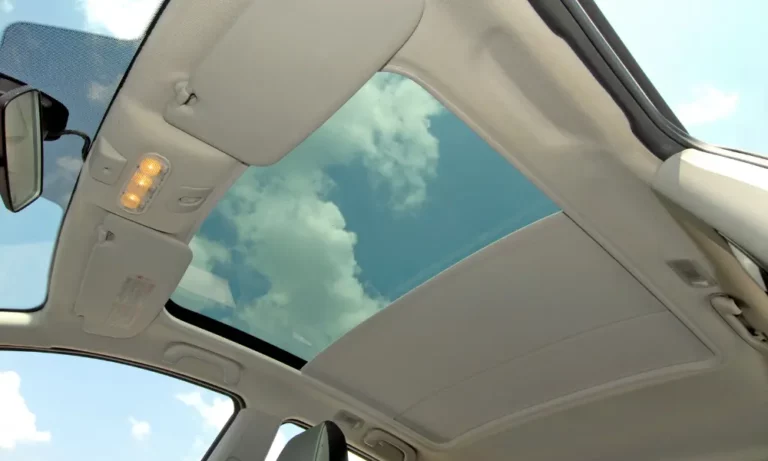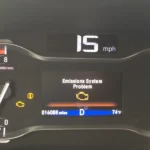Getting your sunroof stuck open can be annoying, especially when unexpected weather hits. You can close your sunroof manually by locating the manual override switch near the sunroof and turning it off. If that doesn’t work, you might need to remove the motor. Understanding these steps can save you from a wet car interior. Stay with us to learn more about each method and keep your car dry.
Understanding the Sunroof Mechanism
To manually close a sunroof, understanding its key parts is helpful. This includes knowing how the motor functions and how you can use manual overrides when the motor fails.
Components of a Sunroof
A sunroof consists of several important parts. The main components include the sunroof panel, which is the part you see and adjust. The sunroof motor is crucial, and it connects to gears and cables that move the panel.
Cables are important because they transfer motion from the motor to the panel. Gears help increase the efficiency of this movement. Knowing the location and role of these parts can make manual operation easier if you ever have to do it.
How the Sunroof Motor Works
The sunroof motor is a tiny yet powerful device that opens or closes the sunroof. When you press the control button, the motor activates. It then turns a series of gears. These gears engage with cables attached to the sunroof panel.
When working properly, this motor moves the cables and, in turn, the sunroof panel smoothly. Understanding this process is crucial to troubleshooting issues. If the motor stops functioning, knowing where it is can ease manual closing or repair tasks.
Manual Override Systems
In certain cars, a manual override system is available for emergencies. This system usually involves a hidden manual crank or switch. You can first look for a panel near your sunroof to locate these features.
Once found, insert and turn the crank to manually move the sunroof. Alternatively, some cars have manual switches near the ceiling that disconnect the motor, allowing manual control. Learning about these options helps prepare you for mechanical failures.
When and Why to Close a Sunroof Manually
Closing a sunroof manually is sometimes necessary, especially if it’s stuck open or if water leaking becomes an issue. Knowing the common reasons and how to assess your sunroof’s condition can help prevent damage and inconvenience.
Common Reasons for Manual Closure
Your sunroof might get stuck open for various reasons. Sometimes, the motor fails due to electrical problems or worn-out parts. In these cases, you may need to close it manually to prevent rain from entering your car.
Another common problem is a sunroof that won’t close completely. This often happens due to debris blocking the tracks or seals. It’s crucial to address this issue quickly to avoid water leaking into your vehicle. This can cause significant damage to your car’s interior, leading to costly repairs.
It’s also possible that the sunroof’s control switch is malfunctioning. If the switch is faulty, the only way to close the sunroof is manually. Having basic tools and knowledge handy can be a lifesaver in these situations.
Assessing Your Sunroof’s Condition
Before attempting any manual closure, it’s important to assess the condition of your sunroof. First, check for debris in the tracks. Leaves, dirt, or even small stones can jam the sunroof.
Next, inspect the seals around the sunroof. These should be intact and free from cracks, as damaged seals can lead to leaks. Water leaking from the sunroof can cause rust or mildew if not addressed promptly.
Lastly, listen for unusual sounds when operating the sunroof. Grinding or clicking noises may indicate mechanical issues that could prevent the sunroof from closing. If you notice any of these signs, manual closure may be necessary until you can get professional help.
Preparation for Manual Closure
Before you start closing your sunroof manually, it’s important to get ready with the right steps. You need to gather the necessary tools and create clear access to the manual override point.
Gathering the Necessary Tools
To close your sunroof manually, you will need a few key tools. First, find a hex wrench, as this is commonly used for operating the manual closure. Check your vehicle’s manual or tool kit that might contain the right size.
Next, have a flashlight handy. It helps to see clearly in dark areas like the headliner where the manual override is located. Keep a small screwdriver ready too, as you might need it to remove any small covers or panels to access the manual controls.
Make sure you have a soft cloth. This will help you clean any dust or debris around the manual mechanism, which might otherwise interfere with its operation. Being prepared helps the process go smoothly.
Clearing Access to the Manual Override
Accessing the manual override spot is essential for operating the sunroof manually. Look for a small panel or cover on your car’s headliner, which is often near the sunroof area. This is where you’ll find the manual override mechanism.
Gently remove the panel using your fingers or a screwdriver. Take care not to damage it or the surrounding areas. This ensures you have clear access and prevents unnecessary repairs.
Once it’s open, inspect the area. Ensure there’s no dirt or obstructions that might block your tools or interfere with the mechanism. Removing obstacles will make it easier to insert the hex wrench and perform the necessary actions to close the sunroof.
Step-by-Step Guide to Closing Your Sunroof
Closing a sunroof manually can seem tricky, especially if you’re not familiar with the process. You need to locate the manual override, work carefully to close the sunroof, and ensure everything is secure once it’s closed.
Locating the Manual Override
Start by finding the manual override. It’s often hidden beneath a cover near the sunroof or on the headliner. Look for a small panel that you can open using a tool like a screwdriver. This panel usually safeguards the override mechanism.
Depending on your car, you might find either a crank or a hex key slot. Make sure you have the right tool, as this is crucial for the next steps.
Manually Closing the Sunroof
With the manual override located, you can start closing the sunroof. Insert the tool—either the crank or hex key—into the appropriate slot. Turn it slowly. As you turn, you’ll engage gears and listen for the sound indicating the sunroof is moving.
Use gentle, steady pressure to avoid stripping the gear. If the sunroof isn’t moving smoothly, double-check your placement and adjust if needed. The cable may require slight repositioning during this step to ensure smooth operation.
Securing the Sunroof After Closure
Once closed, you want to make sure the sunroof is secure. Check that the sunroof aligns properly with the car’s roof line and doesn’t leave any gaps. Test by lightly pressing on the edges to confirm it’s locked in place.
If your car has a safety latch or additional lock, engage it to prevent accidental slides. Reattach the cover on the headliner to protect the manual override. Keep your tools in a handy spot for future use, just in case you need to access the sunroof again.
Troubleshooting Common Issues
When your sunroof is stuck open, it can lead to all sorts of problems, including water leaks. Understanding how to deal with these issues is crucial. Below are steps to help you tackle problems effectively when the manual process isn’t working or when dealing with potential leaks.
When the Manual Override Doesn’t Work
If your sunroof won’t close even with the manual override, the first step is to double-check the override switch location. This switch is often near the front of the sunroof. Ensure it’s in the correct position. If the issue persists, you may need to look at the sunroof motor.
Remove the ceiling panel to access the motor. Be careful and use a screwdriver to disconnect the motor’s power. Sometimes, a simple restart can work wonders. Reconnect the motor and try the override again. If all else fails, consulting a professional mechanic might be necessary.
Addressing Potential Water Leaks
Water leaking into your car from a stuck sunroof can cause serious issues. The first thing you should do is inspect the sunroof for visible debris. Leaves or dirt often block the drains, leading to leaks. It’s essential to clean these regularly.
Locate the drain tubes, usually found in the sunroof’s corners. Use a soft wire or flexible tubing to clear any blockages. If leaks persist, check the sunroof’s seals for any signs of wear or damage. A worn seal may need replacement to ensure a tight closure and prevent future leaks.
Maintaining Your Sunroof Post-Closure
After manually closing your sunroof, keeping it in good working order is important. Focus on regular checks and timely professional help to ensure your sunroof functions smoothly.
Regular Maintenance Tips
Start by cleaning the sunroof’s tracks regularly. Dust and debris can accumulate and block smooth movement. Use a soft brush or a vacuum with a nozzle attachment to remove any loose dirt. This helps keep the sunroof sliding easily.
Check the sunroof’s rubber seals for any cracks or wear. These seals help prevent water from leaking into your car. Applying a silicone-based lubricant can keep these seals flexible and extend their lifespan. Clean and lubricated seals can reduce noise and improve performance.
Don’t forget the sunroof drains. These help channel water away so it doesn’t leak into your vehicle. Clean them periodically with a small wire or string to ensure they’re not clogged. This prevents water damage and keeps the interior dry.
Professional Inspection and Services
Sometimes, manual fixes might not solve all problems. Getting help from a professional is wise if your sunroof motor is struggling or stops working completely. They can examine the sunroof system thoroughly and identify issues before they escalate.
Scheduling a regular inspection of the sunroof, including its motor and all components, can ensure longevity. Experts can do detailed checks and provide services like lubrication of moving parts and replacement of worn-out seals.
Don’t hesitate to consult a repair service if you notice water leaks or unusual noises. Catching problems early can save you time and money in the long run.
Keep your sunroof in top shape by being proactive with maintenance and quick to seek professional advice.



